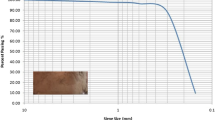Abstract
In general, expansive soils are subjected to high volume changes as a consequence of variations in water content. In the dry season, these soils undergo shrinkage, which causes deep cracks in the soil. Thus, these soils are extremely troublesome for geotechnical engineers, so it is essential to implement the ground improvement techniques. The single-column behavior in expansive soil with and without encasement was discussed in this laboratory model study. The load tests were conducted in a steel tank measuring 50 cm × 50 cm × 50 cm. For the whole study, the column measures 30 mm in diameter and 300 mm in depth and is made of stone chips. The addition of a column increases ultimate strength by 225%. To enhance the strength and rigidity of the column, an encasement using non-woven geotextile was adopted. According to the load tests, a partially encased column improves ultimate strength by 275% and a fully encased column improves ultimate strength by 340%. A conventional column is associated with a lower load limit ratio, whereas a fully encased column is associated with a higher ratio. However, partially encased columns have a minor improvement. The behavior of a column in black cotton soil is influenced by climatic fluctuations, particularly at the 1D to 3D depths. Therefore, the encasement is adopted and lime was injected into the soil bed up to 150 mm deep to reduce the shrinking and swelling characteristics of the soil around the column.
Access this chapter
Tax calculation will be finalised at checkout
Purchases are for personal use only
Similar content being viewed by others
References
Murugesan S, Karpurapu R (2007) Model tests on geosynthetic-encased stone columns. Geosynthet Int 14(6):346–354 (2007). https://doi.org/10.1680/gein.2007.14.6.346
Kumar R, Jain PK (2013) Expansive soft soil improvement by geogrid encased granular pile. Int J Emerg Technol 4(1):55–61
Hugher JMO, Withers NJ (1974) Reinforcing of soft cohesive soils with stone columns. Ground Eng (7):42–49
Alamgir M, Miura N, Pooorooshasbm Madhav MR (1996) Deformation analysis of soft ground reinforced by columnar inclusions. Comput Geotech 18(4):267–290. https://doi.org/10.1016/0266-352X(95)00034-8
Deb K, Behera A (2017) Rate of consolidation of stone column–improved ground considering variable permeability and compressibility in smear zone. Int J Geomech (17). https://doi.org/10.1061/(ASCE)GM.1943-5622.0000830
IS 15284: Part-1 (2003) Design and construction for ground improvement—guidelines, Part-1: stone colums. Indian Standards, Bureau of Indian Standards, New Delhi
Malarvizhi SN, Ilamparuthi (2007) Comparative study on the behavior of encased stone column and conventional stone column. Soil Found (47):873–885. https://doi.org/10.3208/sandf.47.873
Murugesan S, Karpurapu R (2006) Geosynthetic encased stone columns: numerical evaluation. Geotext Geomembr (24): 349–358. https://doi.org/10.1016/j.geotexmem.2006.05.001
Jayarajan J, Karpurapu R (2020) Bearing capacity and settlement response of ordinary and geosynthetic encased granular columns in soft clay analysis and design charts. Ind Geotech J (51):231–253. https://doi.org/10.1007/s40098-020-00457-9
Ambily AP, Shailesh RG (2007) Behavior of stone columns based on experimental and FEM analysis. J Geotech Geoenviron Eng 133:405–415. https://doi.org/10.1061/(ASCE)1090-0241(2007)133:4(405)
Ambily AP, Gandhi SR (2004) Experimental and theoretical evaluation of stone column in sofy clay. ICGGE 201–206
Murugesan S, Karpurapu R (2008) Performance of encased stone columns and design guidelines for construction on soft clay soils. Geosynthet Civ Env Eng (1):729–734. https://doi.org/10.1007/978-3-540-69313-0_133
Fattah MY, AI-Saidi A, Jebur MM (2015) Improvement of bearing capacity of footing on soft clay grouted with lime-silica fume mix. Geomechan Eng (8):113–132. https://doi.org/10.12989/gae.2015.8.1.113
Mitra S, Chath BC (1999) Stone columns and design limitations. In: Proceeding of Indian geotechnical conference held at Culcutta, pp 201–205
Arora S, Kumar, Jain PK (2014) Load settlement behavior of granular pile in black cotton soil. Int J Adv Wengineering Technology. 7(3):773–781
Author information
Authors and Affiliations
Corresponding author
Editor information
Editors and Affiliations
Rights and permissions
Copyright information
© 2023 The Author(s), under exclusive license to Springer Nature Singapore Pte Ltd.
About this paper
Cite this paper
Neelawani, M., Patil, P. (2023). Behavior of Fully and Partially Encased Stone Column in Black Cotton Soil. In: Nandagiri, L., Narasimhan, M.C., Marathe, S. (eds) Recent Advances in Civil Engineering. CTCS 2021. Lecture Notes in Civil Engineering, vol 256. Springer, Singapore. https://doi.org/10.1007/978-981-19-1862-9_8
Download citation
DOI: https://doi.org/10.1007/978-981-19-1862-9_8
Published:
Publisher Name: Springer, Singapore
Print ISBN: 978-981-19-1861-2
Online ISBN: 978-981-19-1862-9
eBook Packages: EngineeringEngineering (R0)




